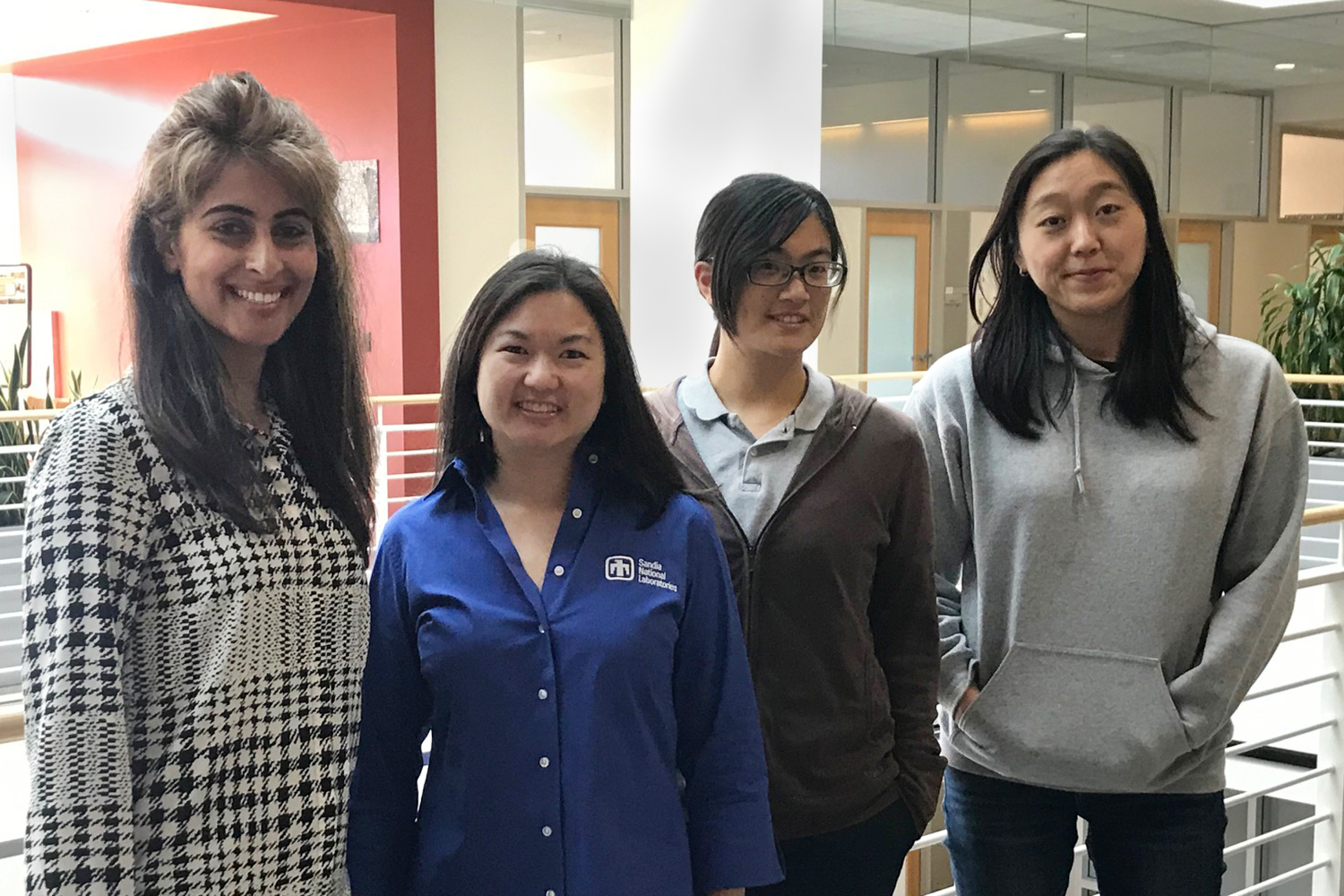Stanford alumni talk career paths with grad students and postdocs
A free and open discussion series hosted by Stanford Women in Electrical Engineering brings alumni back to campus to share their experiences and advice with current students and postdocs thinking about the future.
Current students and postdocs thinking about life after Stanford might consider the experiences and advice of alumni who have been in their shoes before.

Cheryl Lam, center left, with engineering students Maha Yusuf, Elaine Chou and Rebecca Hwang. (Image credit: Alex Kekauoha)
A free and open discussion series hosted by the student group Stanford Women in Electrical Engineering (WEE) invites alums back to campus to discuss their career paths and offer advice for transitioning from Stanford to work life. Although focused on engineering, these talks are open to all students and postdocs and are just some of the many supportive programs offered by WEE.
“Through these industry talks, we hope to bridge the informational gap our students may have regarding different job opportunities in the area following the completion of their PhD and/or postdoc training at Stanford,” said Maha Yusuf, a PhD student in chemical engineering and vice president of WEE.
The industry talks, she said, are intimate events capped at about 20 attendees and offer the chance to network with the speakers, who have diverse professional backgrounds.
Students and postdocs can “broaden their horizons and learn about different opportunities out there, especially if they are interested in industry,” she added.
An alum’s career advice
At the most recent industry talk organized by WEE industry liaisons Elaine Chou and Rebecca Hwang, students and postdocs met Cheryl Lam, the R&D manager for the thermal and fluid science and engineering department at Sandia National Laboratories in Livermore, California. Lam earned her BS and MS degrees in electrical engineering and a PhD in mechanical engineering from Stanford. For Lam, choosing a career path wasn’t a perfect process.
“As an undergrad, I thought I would go to law school,” she said, adding that she even took the LSAT exam. “A PhD was definitely not something I thought I’d do.”
Upon completion of her bachelor’s degree in 2002, Lam took a job with Sandia. With financial support from the company, she later returned to Stanford to begin a master’s program. When asked about pursuing a PhD, she said the decision wasn’t easy, partly because she thought there were some subjects that were just too challenging.
“I think the biggest takeaway of my PhD is that nothing is too hard. You just have to put in the work and focus,” she said. Lam considers herself a “generalist,” meaning that her foundational understanding of subjects like math and physics and an engineering approach have enabled her to learn new topics. Being intellectually fluid has, in turn, allowed her to explore new areas and go farther in her career at Sandia, where she currently leads a large team and oversees a diverse portfolio of R&D projects.
When asked about quelling anxieties before presenting a defense, Lam shared advice that she received as a doctoral student about owning her expertise. “A friend had told me that you are the expert in the room,” she said. “You’re the one who did the research, not anyone else. That’s a helpful thing to keep in mind.”
Many graduate students and postdoctoral scholars will likely find themselves with multiple career options to pursue. Lam said that in the past, she has received many offers but was very intentional in her career moves and followed her instincts.
“I definitely waited for the right job, especially with my recent transition to a management role,” she said. “Other people have come to me with [job offers], but for me it was important to wait for what I thought was the right opportunity. If something didn’t feel right in my gut, then I said, ‘Mmm, I’ll pass.’”
Supportive programming
Industry discussions with alumni such as Lam are just some of the many programs that WEE organizes to help create a sense of belonging and foster a supportive community for Stanford students and postdocs, particularly those in engineering fields. The group also provides opportunities for mentoring, outreach and professional development.
“Other programs of interest are the academic chats or faculty luncheons, during which we highlight a female faculty member and invite her to talk to our graduate students,” Yusuf said.
Among the recent speakers was Marina Radulaski, PhD ’17, assistant professor in electrical engineering and computer science at the University of California, Davis, and a former Stanford postdoc from the Vuckovic research group.
“So many students showed up, including men and women, who were curious about the faculty application process,” Yusuf said.
Yusuf also encourages engineering students and postdocs to get involved with WEE’s “Big Sibling/Little Sibling” program, which pairs first-year grad students with a senior grad student in their field who provides career and academic mentorship.
Outside of careers and academics, WEE hosts several social events, including movie nights and fun outdoor activities.
Stanford students and postdocs are invited to WEE’s upcoming faculty luncheon with Mary Wootters, assistant professor of computer science and of electrical engineering. The event will take place on Wednesday, Nov. 20.
More information about WEE and its various programs and events is available on the group’s website.
